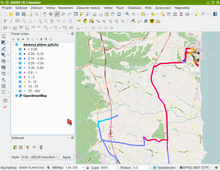Safecast (network)
| Safecast | |
|---|---|
| founding | 2011 |
| founder | Sean Bonner, Joi Ito, Pieter Franken |
| Seat | Dogenzaka ( Shibuya , Japan) |
| Members | Approx. 1580 (end of 2017) |
| Website | safecast.org |

The World Citizen science network SafeCast ( compound from English safe , secure ' and cast , for. Example, footprint') collects honorary measurements of radioactive emissions , validates them and transmits them to an in Internet callable interactive a map. It was created in March 2011 directly after the Fukushima nuclear disaster , after the official measurements of the radioactive fallout and the resulting radiation exposure were incomplete, confusing, misleading and insufficient. By the end of 2016, over 50 million measurements were documented in the publicly accessible Safecast database , around 70% of them from Japan and a relatively large number from Europe .
equipment
The Geiger counters used for measurement are an easy-to-use in-house development with a built-in Global Positioning System (GPS). The built-in sensors ("Geiger-Müller tube" or counter tube ) measure alpha , beta and gamma radiation . The kits for the measuring devices are bought by the network members.
The Safecast measuring device with the lid open (to remove the SD card). Right measuring tape for size classification
Measurements
The devices determine their position using GPS, measure the radiation exposure for over a minute and write the collected data to an internal SD card or save them online in the cloud via an app such as Safecast Drive. The data on the card is read out by the users on a computer, checked and sent to Safecast. A team of currently (at the end of 2016) eight intermediaries will then check them for the network's website.
See also
literature
- Dagmar Röhrlich : From housewife to radiation expert . In: Current Research . deutschlandfunk.de , December 29, 2016 ( online [accessed December 30, 2016]).
Web links
- Safecast.org - Official website
- https://www.youtube.com/watch?v=UyGjdloVPKQ Video about citizen Science, how the Safecast project started and what goals it is pursuing .. (Sean Bonner)
- https://www.youtube.com/watch?v=xumQYbbp9L8 Video about citizen Science, how the project started and what goals it is pursuing, (Pieter Franken)
Individual evidence
- ↑ Safecast: Safecast Tile map. Safecast, accessed in 2017 .
- ↑ safecast.org/tilemap


